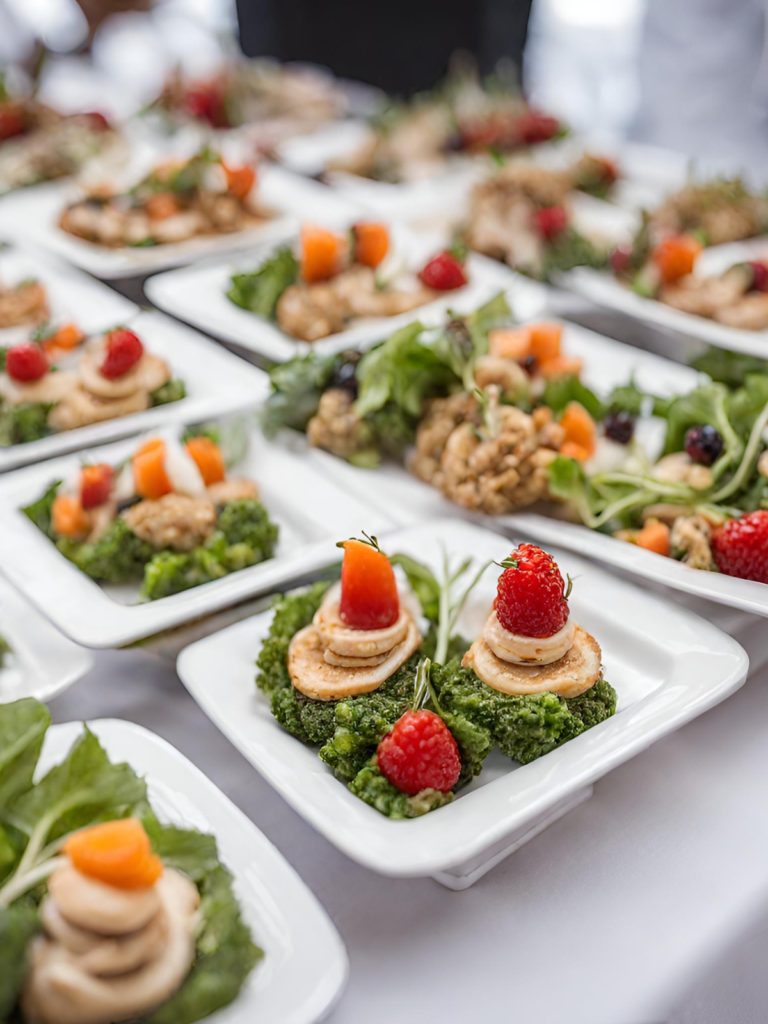Gluten-free catering
Catering businesses face unique challenges when providing gluten-free options to their clients. One major problem is cross-contamination, where gluten-free foods come into contact with gluten-containing ingredients, making it unsafe for people who can’t have gluten due to intolerance or celiac disease. Making certain all staff members are trained enough is crucial to reducing this risk. Employees need to know why it’s so important to have separate places to prepare gluten-free food and separate utensils and places to store them.
By following strict rules and ensuring everyone sticks to them, catering businesses can make it less likely for gluten-free food to get mixed with gluten-containing foods. Another challenge is finding good ingredients that don’t have gluten
. Caterers need to find suppliers who always have gluten-free ingredients available. Building good relationships with these suppliers is extremely important. In short, maintaining high food safety standards and ensuring food quality is important for catering businesses. By dealing with the abovementioned problems, catering businesses can ensure they serve tasty and safe gluten-free food to their customers.
Practical Tips for Gluten-Free Catering
When you’re making food for people with gluten intolerance, you need to plan carefully. Here are some easy steps to help you:
Plan Your Menu: Ensure you have a variety of gluten-free dishes. Use ingredients like rice, quinoa, and potatoes, which don’t have gluten. Letting people choose what they want to eat is also a good idea.
Choose the Right Ingredients: Get your ingredients from places you trust and ensure they’re certified gluten-free. Read the labels carefully to avoid anything with gluten in it. Try to use fresh foods when you can, and keep them separate from anything with gluten.
Cook Safely: Teach your staff how to handle food safely to keep it gluten-free. Use different tools and surfaces for gluten-free cooking. Keep everything clean to stop any gluten from getting into the food.
Have a Special Cooking Area: Make a part of your kitchen for gluten-free food. Keep it separate from where you cook other things, and clean it well.
Be Clear and Honest: Tell your customers clearly what food is gluten-free. Put it on menus and signs, and explain it to them if they ask. Give them lists of ingredients, so they know what’s in their food.
Following these tips will help you make delicious food everyone can enjoy, even if they can’t eat gluten.
Benefits of Offering Gluten-Free Catering

Gluten-Free Catering
Offering gluten-free catering unlocks a treasure trove of advantages for your business. Here’s a look at three key benefits:
Grow Your Guest List: Celiac disease and gluten sensitivity are rising. By catering to these dietary needs, you open your doors to a new customer base who might otherwise have to skip your event. This means more potential clients and a livelier atmosphere.
Culinary Creativity Takes Center Stage: Going gluten-free doesn’t have to mean sacrificing flavor. It’s a chance to showcase your culinary skills with innovative recipes using naturally gluten-free ingredients like quinoa, almond flour, and fresh vegetables. Your delicious offerings will leave a lasting impression on all your guests.
Building Loyalty Through Inclusivity: When you show that you care about accommodating diverse dietary needs, you send a powerful message of inclusivity. This fosters a positive reputation and builds customer loyalty. Your guests will appreciate the extra effort and feel more welcome, making them more likely to return for future events.
Gluten and Its Impact
Gluten is a protein complex in grains like wheat, barley, and rye. It acts as a glue, giving dough elasticity and baked goods their characteristic rise. While perfectly harmless, gluten can trigger health problems in individuals with specific conditions. Let’s delve deeper into gluten’s role and its impact on health.
Where Does Gluten Hide?
Gluten lurks in many everyday foods, not just bread and pasta. Here’s a sneak peek:
Grains and Cereals: Wheat (all varieties), barley, rye, spelled, and triticale (a wheat-rye hybrid)
Baked Goods: Bread, crackers, cookies, pastries, cakes, muffins, cereals
Processed Foods: Soups, sauces, salad dressings, condiments, beer, soy sauce, processed meats.
The Spectrum of Gluten Sensitivity:
Celiac Disease: This autoimmune disorder triggers an immune system attack on the small intestine when gluten is ingested. Damage to the villi (tiny finger-like projections that absorb nutrients) leads to malabsorption and symptoms like diarrhea, bloating, weight loss, fatigue, and nutrient deficiencies. Left untreated, celiac disease can have serious health consequences.
Gluten Sensitivity: While not an autoimmune disease, some people experience unpleasant digestive symptoms like bloating, gas, diarrhea, or constipation after consuming gluten. Unlike celiac disease, there’s no damage to the small intestine. The cause of gluten sensitivity is still being researched, but it might be related to difficulty digesting specific components of gluten. Whether managing your gluten sensitivity or catering to diverse nutritional needs, being aware of gluten and its presence in everyday foods goes a long way in creating a healthier and happier community.
The Café Gluten-Free Experience
While the primary focus is gluten-free, a gluten-free café can further distinguish itself by catering to a wider range of dietary needs within the gluten-free spectrum. This demonstrates inclusivity and allows your restaurant to cater to a broader customer base.
Vegan & Dairy-Free Delights:
Offer a selection of vegan and dairy-free options for breakfast, lunch, and desserts. Use alternative milk like almond, oat, or soy for beverages and incorporate plant-based proteins and dairy-free cheeses into dishes.
Nut-Free Awareness:
Be mindful of customers with nut allergies. Clearly label all dishes containing nuts and offer alternative options for those seeking nut-free choices. Consider designating a nut-free zone within the café for added comfort.
Soy-Free Solutions:
For those with soy sensitivities, offer soy-free options like coconut milk or chickpea flour for baking. Clearly highlight soy-free ingredients on menus and have staff trained to answer customer inquiries.
Flavor for Every Craving:
A gluten-free café is only complete with a menu that tantalizes taste buds and caters to diverse preferences. Here’s a breakdown of essential breakfast, lunch, and sweet treat options, along with beverage selections to ensure a delightful dining experience for everyone.


